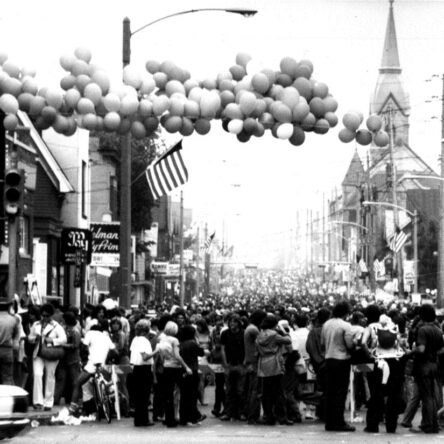Brady Street
As a main thoroughfare through one of the city’s most famous neighborhoods, Brady Street has seen Milwaukee grow, change, and celebrate for over 150 years. The nine-block stretch running east to west through the East Side exemplifies the ethnic diversity and festival heritage of Milwaukee.
Starting in the 1860s, the area around Brady Street became a burgeoning neighborhood for the Polish immigrants employed at the tanneries located along the east side of the Milwaukee River. The oldest surviving buildings in the neighborhood and along Brady Street itself were built by this generation of immigrant families. Most famous is St. Hedwig’s Roman Catholic Church on Humboldt Avenue, which was completed in 1887.
By the 1920s, Italians were the predominant ethnic group that called the neighborhood home. The storefronts of family-owned bakeries, delis, and other businesses along Brady Street still bear the names of the Italian families that lived and worked in the community throughout the twentieth century.
The historic ethnic diversity of the neighborhood, coupled with its proximity to the University of Wisconsin-Milwaukee, contributed to Brady Street becoming the center of the city’s anti-war and counterculture movement in the 1960s and 1970s. At this time, the tightly packed storefronts of Brady Street alternated between art studios, head shops, antique dealers, bars, and Italian delis.
Starting in 1973, the eclectic neighborhood would gather twice a year in June and September for a weekend festival known originally as Brady Street Days. This photo looking west down Brady Street captures the energy of Milwaukee’s East Side in the 1970s. Hippies, students, blue collar workers, and neighborhood families would pack onto Brady Street under the shadow of St. Hedwig’s spire to eat, drink, dance, shop, and listen to music as one community. However, increased crime on Brady Street brought the semi-annual festival to an end in 1981.
The Brady Street Festival was eventually revived in 2004 when it became an annual event held in mid-summer. Today, the Brady Street Festival is again a yearly neighborhood gathering of diverse Milwaukee residents with drinking, food, music and local vendors. The nine-block street that started as a small residential neighborhood for immigrant tannery workers has grown, changed, and blossomed into one of the city’s main cultural hubs.
CURRICULUM:
Learn more with Viewaukee curriculum for the home or classroom.
Brady Street Curriculum

